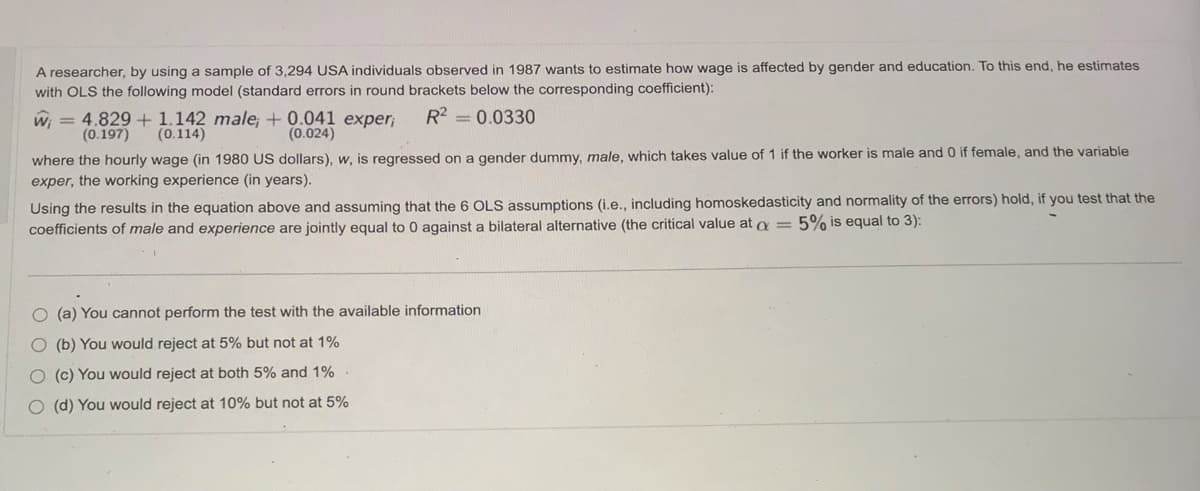A researcher, by using a sample of 3,294 USA individuals observed in 1987 wants to estimate how wage is affected by gender and education. To this end, he estimates with OLS the following model (standard errors in round brackets below the corresponding coefficient): R2 = 0.0330 w; = 4.829 + 1.142 male, + 0.041 exper; (0.197) (0.114) (0.024) where the hourly wage (in 1980 US dollars), w, is regressed on a gender dummy, male, which takes value of 1 if the worker is male and 0 if female, and the variable exper, the working experience (in years). Using the results in the equation above and assuming that the 6 OLS assumptions (i.e., including homoskedasticity and normality of the errors) hold, if you test that the coefficients of male and experience are jointly equal to 0 against a bilateral alternative (the critical value ata= 5% is equal to 3):
A researcher, by using a sample of 3,294 USA individuals observed in 1987 wants to estimate how wage is affected by gender and education. To this end, he estimates with OLS the following model (standard errors in round brackets below the corresponding coefficient): R2 = 0.0330 w; = 4.829 + 1.142 male, + 0.041 exper; (0.197) (0.114) (0.024) where the hourly wage (in 1980 US dollars), w, is regressed on a gender dummy, male, which takes value of 1 if the worker is male and 0 if female, and the variable exper, the working experience (in years). Using the results in the equation above and assuming that the 6 OLS assumptions (i.e., including homoskedasticity and normality of the errors) hold, if you test that the coefficients of male and experience are jointly equal to 0 against a bilateral alternative (the critical value ata= 5% is equal to 3):
Linear Algebra: A Modern Introduction
4th Edition
ISBN:9781285463247
Author:David Poole
Publisher:David Poole
Chapter7: Distance And Approximation
Section7.3: Least Squares Approximation
Problem 31EQ
Related questions
Question

Transcribed Image Text:A researcher, by using a sample of 3,294 USA individuals observed in 1987 wants to estimate how wage is affected by gender and education. To this end, he estimates
with OLS the following model (standard errors in round brackets below the corresponding coefficient):
R2
w; = 4.829 + 1.142 male; +0.041 exper;
(0.197)
(0.114)
0.0330
(0.024)
where the hourly wage (in 1980 US dollars), w, is regressed on a gender dummy, male, which takes value of 1 if the worker is male and 0 if female, and the variable
exper, the working experience (in years).
Using the results in the equation above and assuming that the 6 OLS assumptions (i.e., including homoskedasticity and normality of the errors) hold, if you test that the
coefficients of male and experience are jointly equal to 0 against a bilateral alternative (the critical value at a = 5% is equal to 3):
O (a) You cannot perform the test with the available information
O (b) You would reject at 5% but not at 1%
O (c) You would reject at both 5% and 1%
O (d) You would reject at 10% but not at 5%
Expert Solution
This question has been solved!
Explore an expertly crafted, step-by-step solution for a thorough understanding of key concepts.
Step by step
Solved in 4 steps

Recommended textbooks for you

Linear Algebra: A Modern Introduction
Algebra
ISBN:
9781285463247
Author:
David Poole
Publisher:
Cengage Learning

Glencoe Algebra 1, Student Edition, 9780079039897…
Algebra
ISBN:
9780079039897
Author:
Carter
Publisher:
McGraw Hill

Linear Algebra: A Modern Introduction
Algebra
ISBN:
9781285463247
Author:
David Poole
Publisher:
Cengage Learning

Glencoe Algebra 1, Student Edition, 9780079039897…
Algebra
ISBN:
9780079039897
Author:
Carter
Publisher:
McGraw Hill